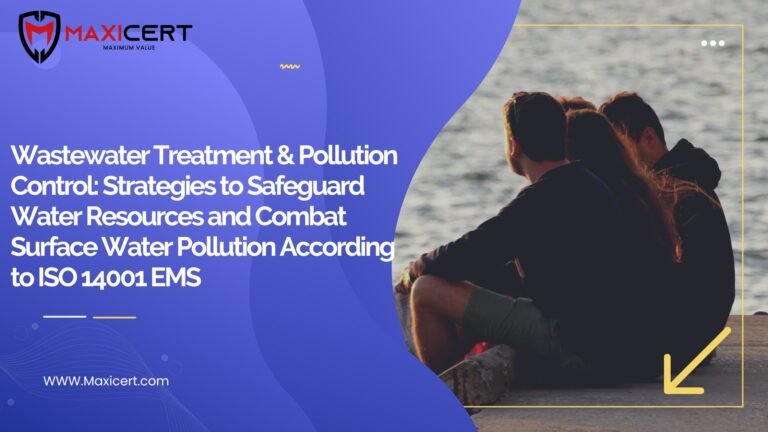Wastewater Treatment & Pollution Control: Strategies to Safeguard Water Resources and Combat Surface Water Pollution According to ISO 14001 EMS

Introduction
Water pollution is a pressing global issue that threatens ecosystems, human health, and economic stability. As industrialization and urbanization continue to expand, the need for effective wastewater treatment and pollution control becomes increasingly critical. This blog explores the causes and effects of water pollution, delves into the hydrologic cycle, and outlines contemporary wastewater treatment methods, including primary, secondary, and advanced techniques. By understanding these ISO processes, industries and municipalities can adopt sustainable practices to protect our precious water resources for future generations.
Water pollution refers to the qualitative state of impurity or uncleanliness in hydrologic waters of a certain region, such as a watershed. It results from an occurrence or process, which causes a reduction in the utility of the earth’s waters, especially as, related to human health and environmental effects. The pollution process stresses the loss of purity through contamination, which further implies intrusion by or contact with an outside source as the cause.
What are hydrologic waters?
The earth’s natural waters may be viewed as a continuously circulating system, which provides a graphic illustration of waters in the hydrologic cycle, including both surface and subsurface waters.
Request A Free Quote
What is the hydrologic cycle?
As a reference for water quality, distilled waters (H₂O) represent the highest state of purity. Waters in the hydrologic cycle may be viewed as natural, but are not pure. They become polluted from both natural and human activities. Natural degradation effects may result from a myriad of sources from fauna, flora, volcano eruptions, lightning strikes causing fires and so on, which on a long-term basis are considered to be prevailing background levels for scientific purposes.
Human-made pollution disrupts the natural balance by super-imposing waste materials discharged from various sources. Pollutants may be introduced into the waters of the hydrologic cycle at any point. For example: atmospheric precipitation (rainfall) may become contaminated by air pollutants; surface waters may become polluted in the run-off process from watersheds; sewage may be discharged into streams and rivers; and groundwaters may become polluted through infiltration and underground contamination.
Pollution is then super-imposed on these waters and may therefore be viewed as an unnatural or unbalanced environmental condition. The process of pollution may occur in waters of any part of the hydrologic cycle, and is more obvious on the earth’s surface in the form of run-off from watersheds into streams and rivers. However, groundwater pollution is also of major environmental impact.
Techniques for reducing pollution in wastewater discharges
- Municipalities, sanitary districts, industries, commercial enterprises and various pollution control commissions typically carry out large-scale wastewater treatment.
- In general, all processes of wastewater treatment may be grouped into physical, chemical or biological types, and one or more of these may be employed to achieve a desired effluent product.
General classification of wastewater treatment operations and processes according to ISO 14001
- Physical Operations
Flow measurement, screening / grit removal, mixing, flocculation, sedimentation, flotation, filtration, drying, distillation, centrifuging, freezing, reverse osmosis.
- Chemical Processes
Precipitation, neutralization, adsorption, disinfection, chemical oxidation, chemical reduction, incineration, ion exchange, electrodialysis.
- Biological Processes
Aerobic action, anaerobic action, aerobic-anaerobic combinations.
Contemporary methods of wastewater treatment as per ISO 14001
The coverage here is intended to provide a conceptual overview of current wastewater treatment practices around the world. Municipal wastewaters along with some intermingling of industrial / commercial wastes are treated in systems commonly employing primary. secondary and tertiary treatment as follows:
- Primary treatment
The basic objective of primary treatment for municipal wastewaters, including domestic sewage intermingled with some industrial / commercial wastes, is to remove suspended solids and clarify the wastewater, to make it suitable for biological treatment. After some pre-treatment handling such as screening, grit removal and combination, the main process of primary sedimentation is the settling of the raw wastewater in large settling tanks for periods up to several hours. This process removes from 50 to 75% of the total suspended solids, which are drawn off as underflow sludge collected for separate treatment. The overflow effluent from the process then is directed for secondary treatment. In certain cases, chemicals may be employed to improve the degree of primary treatment.
- Secondary treatment
The portion of the organic content of the wastewater, which is finely suspended or dissolved and not removed in the primary process, is treated by secondary treatment. The generally accepted forms of secondary treatment in common use include trickling filters, biological contactors such as rotating discs, activated sludge, waste stabilization ponds, aerated pond systems and land application methods, including wetland systems. All of these systems will be recognized as employing biological processes of some form or another. The most common of these processes are briefly discussed below.
Biological contactor systems: Trickling filters are one of the earliest forms of this method for secondary treatment and are still widely used with some improved methods of application. In this treatment, the effluent from the primary tanks is applied uniformly onto a bed of media, such as rock or synthetic plastic media. Uniform distribution is accomplished typically by trickling the liquid from perforated piping rotated over the bed intermittently or continuously according to the desired process. Depending on the rate of organic and hydraulic loadings trickling filters can remove up to 95% of the organic content, usually analyzed as biochemical oxygen demand (BOD).
There are numerous other more recent biological contactor systems in use which can provide treatment removals in the same range; some of these methods offer special advantages, particularly applicable in certain limiting conditions such as space, climate and so on. It is to be noted that a following secondary settling tank is considered to be a necessary part of completing the process. In secondary settling, some so-called humus sludge is drawn off as an underflow, and the overflow is discharged as a secondary effluent.
Activated sludge: In the most common form of this biological process, primary treated effluent flows into an activated sludge unit tank containing a previous existing biological suspension called activated sludge. This mixture is referred to as mixed liquor suspended solids (MLSS) and is provided a contact period typically ranging from several hours up to 24 hours or more, depending on the desired results. During this period the mixture is highly aerated and agitated to promote aerobic biological activity. As the process finalizes, a portion of the mixture (MLSS) is drawn off and returned to the influent for continuation of the biological activation process. Secondary settling is provided following the activated sludge unit for the purpose of settling out the activated sludge suspension and discharging a clarified overflow as effluent. The process is capable of removing up to about 95% of the influent BOD.
Conclusion
Water pollution is a critical environmental issue that impacts ecosystems, human health and economic development. Effective wastewater treatment methods, including primary, secondary and advanced treatment techniques, play a vital role in minimizing pollution and ensuring safe water discharge. By adopting modern wastewater treatment technologies and sustainable practices, industries and municipalities can contribute to cleaner water bodies, improved public health and a healthier environment for future generations.

Get In Touch

Get In Touch

Get In Touch
Need A Free Estimate?
Get a free consultation and Checklist to get certified for ISO , HALAL, CE Mark Certification.
FAQ
What are the main causes of water pollution?
Water pollution is caused by industrial discharge, agricultural runoff, untreated sewage and improper waste disposal, leading to contamination of surface and groundwater sources.
What is the difference between primary and secondary wastewater treatment?
Primary treatment removes suspended solids through sedimentation, while secondary treatment uses biological processes to break down organic matter and reduce biochemical oxygen demand (BOD).
How effective is wastewater treatment in reducing pollution?
- Modern wastewater treatment systems can remove up to 95% of organic pollutants and significantly reduce contaminants before releasing treated water into the environment.





